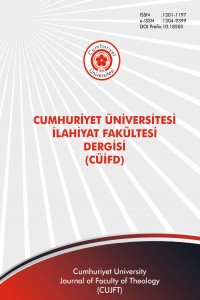Öz
Hz. Peygamber'e izâfe edilen bir söz veya fiilin ona ait olup olmadığı tesbit
edilirken senet ve metne yönelik olmak üzere iki açıdan bir değerlendirmeye tâbi tutulur.
Peygambere ait olduğu konusunda galip bir zanna sahip olabilmek için, ilgili rivayetin,
sahih hadisin tanımında yer alan şartları taşımasının yanısıra, rivâyet metninin, Kur'an'a,
akla, sünnete, bilime ve tarihî gerçeklere ters düşmemesi, rekâket (mânâ bozukluğu)
taşımaması da gerekir.
Bir sözü değerlendirirken, o sözü; kim söylemiş, kime söylemiş, ne maksatla
söylemiş, ne makamda söylemiş? gibi soruları sormak, belağat kaidesidir. İnsanlar bütün
söz ve davranışlarını, sahip oldukları şahsiyet ve konumlarına uygun bir biçimde
sergilerler. Bütün bu gerçeklerden hareketle, rivâyetlerin değerlendirilmesinde Hz.
Peygamber’in kullanabileceği üslûptan, şahsiyet ve konumundan da yararlanılması
gerektiğini söylemek mümkündür. Dolayısıyla peygambere izâfe edilen bir rivâyetin ona
ait olabilmesi için, yukarıdaki şartlara ilâveten, o rivâyetin bir de hem mânâ hem
uygulama olarak "peygamberin üslûbuna, üstün şahsiyet ve konumuna uygun olması"
gerekir.
Böyle bir yaklaşım, yegâne olmasa da, bazı doğruların tesbitinde büyük yardımı
olacağı muhakkaktır. Bu makalemizde bir rivâyetten hareketle böyle bir uygulamayı
örneklendirmeye çalıştık. Sened ve metin tenkidine tabi tutulan bu rivayetin üç ayrı
versiyonu vardır. Her bir versiyon ayrı ayrı ve detayli bir şekilde ele alınmış, muhtemel
sonuçlar değerlendirilmiştir.
Anahtar Kelimeler
Kaynakça
- Cumhuriyet Üniversitesi
- İlahiyat Fakültesi Dergisi
- Cilt: VII / 1, s. 21-59
- Haziran-2003-SİVAS
- RİVÂYETLERİN DEĞERLENDİRİLMESİNDE
- HZ. PEYGAMBER'İN ŞAHSİYET VE KONUMUNDAN YARARLANMANIN ROLÜ
- Cemal AĞIRMAN*
Öz
When determining whether a saying or an act which is attributed to the Prophet
does relly belong to him or not, they are subjected to an examination of sanad (the chain
of narratives) and text together. To have a strong conviction whether that saying or act
belongs to the prophet, it is required that the text of narratives mustn't contradict the
Qur'an, reason, the Sunna, solid scientific findings and historical facts at the same time
complying the conditions in the definition of the hadith al-sahîh.
When evaluating an expression, it is accepted as a rule of eloquence to ask such
questions as "who said that expression, to whom was it said, for which purpose was it
said, in which place was it said?" People utter their speeches and display their behaves
in accordance with their character and situation. When evaluating the narratives
attributed to the Prophet, it is important to test them comparing them with the general
structure of the prophet's genre, personality and his status in that social milieu. So, in
order to assume that a narrative attributed to the Prophet really belongs to him, it is
expected to be consistent with the Prophet's manner, his gloried character and social
condition besides the above mentioned conditions.
It is obvious that this kind of approach will make important contributions to
determining some true points related to the present problem . In this article, we tried to
give an example of such kind of application on a narrative. This narrative which is
subjected to criticism from the perspective of its sanad (the chain) and text has got three
variations. Each variation was taken up one by one in detail, and the possible results
were evaluated.
Anahtar Kelimeler
Kaynakça
- Cumhuriyet Üniversitesi
- İlahiyat Fakültesi Dergisi
- Cilt: VII / 1, s. 21-59
- Haziran-2003-SİVAS
- RİVÂYETLERİN DEĞERLENDİRİLMESİNDE
- HZ. PEYGAMBER'İN ŞAHSİYET VE KONUMUNDAN YARARLANMANIN ROLÜ
- Cemal AĞIRMAN*
Ayrıntılar
| Bölüm | Araştırma Makaleleri |
|---|---|
| Yazarlar | |
| Yayımlanma Tarihi | 15 Haziran 2003 |
| Yayımlandığı Sayı | Yıl 2003 Cilt: 7 Sayı: 1 |
CUIFD Creative Commons Atıf-Gayriticari-Türetilemez 4.0 Uluslararası Lisansı ile lisanslanmıştır.


